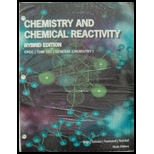
CHEMISTRY+CHEM...HYBRID ED.(LL)>CUSTOM<
9th Edition
ISBN: 9781305020788
Author: John C.Kotz, Paul M. Treichel, John Townsend, David Treichel
Publisher: CENGAGE C
expand_more
expand_more
format_list_bulleted
Question
Chapter 24.1, Problem 2RC
Interpretation Introduction
Interpretation: Under physiological condition, behavior of amino acid to be identified.
Concept Introduction:
Proteins: Proteins are
Expert Solution & Answer
Want to see the full answer?
Check out a sample textbook solution
Students have asked these similar questions
A partir de Aluminio y Co(NO3)2ꞏ6H2O, indicar las reacciones a realizar para obtener Azul de Thenard (Al2CoO4).
To obtain Thenard Blue (Al2CoO4), the following reaction is correct (performed in an oven):Al(OH)3 + Co(OH)2 → Al2CoO4 + 4 H2O
Problem 38 can u explain and solve thanks april 24
Chapter 24 Solutions
CHEMISTRY+CHEM...HYBRID ED.(LL)>CUSTOM<
Ch. 24.1 - Draw the Lewis structure for the tripeptide...Ch. 24.1 - Prob. 1RCCh. 24.1 - Prob. 2RCCh. 24.1 - Prob. 3RCCh. 24.2 - Prob. 1RCCh. 24.2 - Prob. 2RCCh. 24.2 - Prob. 3RCCh. 24.3 - What is the sequence of the strand of DNA...Ch. 24.3 - Prob. 2CYUCh. 24.3 - 1. Which breaks down more quickly in an aqueous...
Ch. 24.3 - Prob. 2RCCh. 24.3 - 3. Which amino acid is selected by the mRNA codon...Ch. 24.3 - Kynamro has the hydrogen bonding sequence:...Ch. 24.3 - The formula of Kynamro is...Ch. 24.3 - Prob. 3QCh. 24.4 - 1. Which of the following is not an example of a...Ch. 24.4 - Prob. 2RCCh. 24.5 - Prob. 1RCCh. 24.5 - Prob. 2RCCh. 24.5 - Prob. 1QCh. 24.5 - Prob. 2QCh. 24.5 - Prob. 3QCh. 24 - (a) Draw the Lewis structure for the amino acid...Ch. 24 - (a) Draw the Lewis structure for the amino acid...Ch. 24 - Prob. 3PSCh. 24 - Prob. 4PSCh. 24 - Draw Lewis structures for the two dipeptides that...Ch. 24 - Do the amino acid sequences: valine-asparagine and...Ch. 24 - Draw the Lewis structure for the tripeptide...Ch. 24 - Prob. 8PSCh. 24 - Prob. 9PSCh. 24 - Prob. 10PSCh. 24 - Prob. 11PSCh. 24 - Prob. 12PSCh. 24 - (a) Draw the structural formula for the sugar...Ch. 24 - (a) Draw the structural formula for the sugar -D-2...Ch. 24 - Prob. 15PSCh. 24 - Prob. 16PSCh. 24 - Given the following nucleotide sequence in DNA:...Ch. 24 - Given the following nucleotide sequence in DNA: 5'...Ch. 24 - Prob. 19PSCh. 24 - If a drop of oleic acid is added to a dish of...Ch. 24 - What structure do all steroids have in common?Ch. 24 - Prob. 22PSCh. 24 - Prob. 23PSCh. 24 - The chemical equation for the fermentation of...Ch. 24 - Prob. 25PSCh. 24 - Prob. 26PSCh. 24 - Prob. 27GQCh. 24 - Prob. 28GQCh. 24 - Prob. 29GQCh. 24 - Prob. 30GQCh. 24 - Prob. 31GQCh. 24 - There are 41 = 4 mononucleotides of DNA, there are...Ch. 24 - Prob. 33GQCh. 24 - The first step of the metabolic process known as...Ch. 24 - Prob. 35ILCh. 24 - Insulin is a protein important in the metabolism...Ch. 24 - Prob. 37SCQCh. 24 - Prob. 38SCQCh. 24 - Do the DNA sequences ATGC and CGTA represent the...Ch. 24 - Prob. 41SCQCh. 24 - Which of the following statements is/are true? (a)...
Knowledge Booster
Learn more about
Need a deep-dive on the concept behind this application? Look no further. Learn more about this topic, chemistry and related others by exploring similar questions and additional content below.Similar questions
arrow_back_ios
SEE MORE QUESTIONS
arrow_forward_ios
Recommended textbooks for you
 Chemistry: Principles and PracticeChemistryISBN:9780534420123Author:Daniel L. Reger, Scott R. Goode, David W. Ball, Edward MercerPublisher:Cengage Learning
Chemistry: Principles and PracticeChemistryISBN:9780534420123Author:Daniel L. Reger, Scott R. Goode, David W. Ball, Edward MercerPublisher:Cengage Learning Chemistry: Principles and ReactionsChemistryISBN:9781305079373Author:William L. Masterton, Cecile N. HurleyPublisher:Cengage Learning
Chemistry: Principles and ReactionsChemistryISBN:9781305079373Author:William L. Masterton, Cecile N. HurleyPublisher:Cengage Learning

Chemistry: Principles and Practice
Chemistry
ISBN:9780534420123
Author:Daniel L. Reger, Scott R. Goode, David W. Ball, Edward Mercer
Publisher:Cengage Learning

Chemistry: Principles and Reactions
Chemistry
ISBN:9781305079373
Author:William L. Masterton, Cecile N. Hurley
Publisher:Cengage Learning
What are CHNOPS? These Chemical Elements = 98% of Life | Biology | Biochemistry; Author: Socratica;https://www.youtube.com/watch?v=w90wFlR53VM;License: Standard YouTube License, CC-BY